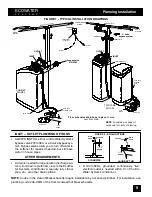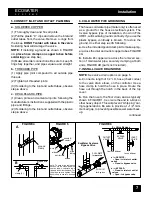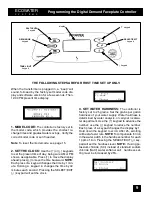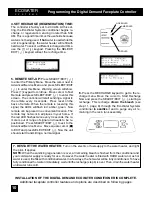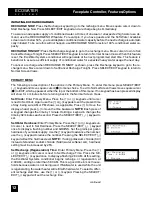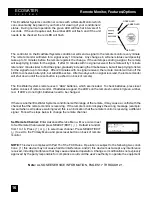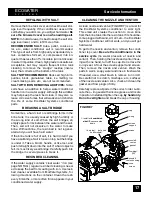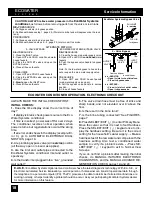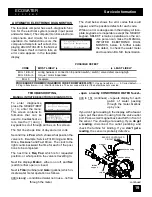
4
ECOWATER
S Y S T E
M S
Water Conditioning
WATER CONDITIONING
Water conditioning is the treatment of several condi-
tions occuring in household water. The conditions
treated by the unit you have purchased are: (1)
Hardness, (2) Iron, (3) Sediments, (4) Barium and
(5) Radium 226 and 228. These are described be-
low:
1. HARDNESS
is a term to describe the presence of
calcium and magnesium minerals in water. A chemi-
cal analysis accurately measures the amount of
minerals in grain weight. For example, one gallon of
water with 5 grains per gallon (gpg) hardness has
dissolved minerals, that if solidified, about equals
the size of one ordinary aspirin tablet. One gallon of
water, 25 gpg hard, has a mineral content equal in
size to 5 aspirin tablets. Water hardness varies
greatly across the country. It generally contains from
3 to 100 gpg.
Hard water affects living in general. Hardness min-
erals combine with soap to make a soap curd. The
curd greatly reduces the cleaning action of soap.
Precipitated hardness minerals form a crust on
cooking utensils, appliances, and plumbing fixtures.
Even the tastes of foods are affected. A water soft-
ener removes the hardness minerals to eliminate
these problems, and others.
IMPORTANT: Water softeners using sodium chlo-
ride (NaCl) salt for regeneration add sodium to the
water. Persons on sodium restricted diets should
consider the added sodium as part of their overall in-
take. Water softeners using potassium chloride
(KCl) salt for regeneration add potassium to the wa-
ter. Persons on potassium restricted diets should
consider the added potassium as part of their overall
intake.
2. IRON
in water is measured in parts per million
(ppm). The total* ppm of iron, and type or types*, is
determined by chemical analysis. Three different
types of iron in water are: (a) Ferrous (clear water),
(b) Ferric (red water), and (c) Bacterial and organi-
cally bound iron.
*Water may contain one or more of the four types of
iron and any combination of these. Total iron is the
sum of the contents.
a. Ferrous
(clear water) iron is soluble and dis-
solves in water. It is usually detected by taking a
sample of water in a clear bottle or glass. Immediate-
ly after taking, the sample is clear. As the water sam-
ple stands, it gradually clouds and turns slightly yel-
low or brown as air oxidizes the iron. This usually
occurs in 15 to 30 minutes. An EcoWater Systems
conditioner will remove moderate amounts of this
type of iron (see specifications).
b. Ferric
(red water), and
c. Bacterial and organi-
cally bound
irons are insoluble. This iron is visible
immediately when drawn from a faucet because it
has oxidized before reaching the home. It appears
as small cloudy yellow, orange, or reddish sus-
pended particles. After the water stands for a period
of time, the particles settle to the bottom of the con-
tainer. Generally these irons are removed from wa-
ter by filtration. Chlorination is also recommended
for bacterial iron. An EcoWater Systems conditioner
will remove minimal quantities (see specifications)
of ferric iron.
3. SEDIMENT
is fine, foreign material particles sus-
pended in water. This material is most often clay or
silt. Extreme amounts of sediment may give the wa-
ter a cloudy appearance. A sediment filter normally
corrects this condition.
4. BARIUM
is a naturally occurring metal that makes
its way into water through drilling wastes, smelting
copper, and producing motor vehicle parts. The En-
vironmental Protection Agency (EPA) has the au-
thority to determine chemicals that cause health ef-
fects and at what levels. EPA created a list of
harmful chemicals and their maximum contaminant
levels (MCL), to set limits for public water supplies
to maintain. Barium’s MCL is 2 parts per million
(PPM). The level of barium in water can be deter-
mined through a chemical analysis.
5. RADIUM
is a naturally occurring radioactive metal
that can be found in most drinking water at low lev-
els. Higher levels occur when ground water passes
through bedrock containing high concentrations of
radium. Radium 226 and 228 are also regulated by
EPA with an MCL of 5 picocuries per liter (pCi/l). A
chemical analysis is needed to measure the con-
centration of Radium 226 and 228.






